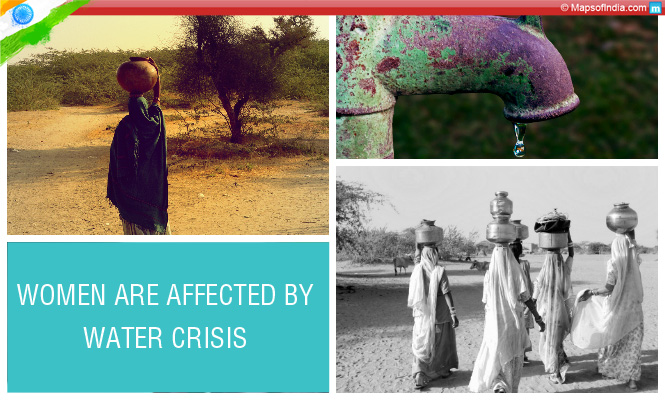The water crisis in India is actually a woman’s issue. The problem of water shortage is not only related to the fact that there is more demand and less supply of water but also related to some of the major women’s issues like women’s rights, development, education, health, sanitation and preventable deaths.
There is no doubt about the fact that India is facing a severe water shortage problem. Data released by the National Sample Survey Organisation for the year 2012 reveal that because of over-harvesting of ground water in rural areas, the problem of water crisis is severe in these areas and the per capita availability of water in India is reducing. Most of the rural areas are depending on the reduced ground water level for their daily water supply, as other sources are drying up. The result is that even today, the rural Indian women have to walk a long distance to fetch potable water. It is the women of the house, including the girls, who are in charge of collecting water for everyday use.
According to the NSSO report, in 2012 more than half of the rural women population had to walk from 200 metres to 5 km every day to get water, which means they travelled everyday for 20-30 minutes on an average to get drinking water. Plus they also have to spend another 15-20 minutes at these sources to draw water. At times, a woman has to make multiple trips to a local water source to meet the day’s supply of water. If calculated in mathematical terms, an Indian rural woman almost spends 210 hours in a year to get water. These can be fetching water from wells, tube wells or rivers located at far off areas. Very rarely you find these water sources nearby.
Even in the urban areas, the situation is not good. We see women in urban slums waiting in long queues with buckets in hand to get water from the municipality water tanks at a fixed time of the day.
Consequences
- Lack of safe drinking water: Leaving aside the problem of fetching water from distant areas, it is observed that only 5-10% of the rural Indian households treat water before consuming. More than 90% of the families do not have access to safe drinking water. Even after so many years of Independence, to get safe drinking water is a distant dream in rural India.
- Women’s health affected: Collecting and carrying water on a daily basis is not an easy job. Irrespective of the weather, whether hot or cold, they are bound by responsibilities to look after their household. Carrying heavy loads of bucket or pot of water on heads or on their shoulders and walking a long distance, along with managing all other duties, takes a toll of their health, creating back and feet ache and other posture problems.
- Susceptible to infections: Indian rural women are at a greater risk for infections due to their contact with polluted water most of the time. Indian rural women and girls collecting water are more prone to severe infectious diseases like trachoma, hepatitis A, diarrhoea, dysentery, and leptospirosis, a water-borne bacterial infection caused by animal urine.
- Lack of sanitation: Lack of water supply is also linked with lack of sanitation and lack of toilet facilities in rural areas for women. In fact, this is a big problem faced by most rural women in India. They are not used to a proper hygienic way of living during menstruation cycles because there are no toilet facilities and no running water supply at their homes. Even today, women have to go to desolate places for nature’s call and in most cases, they get assaulted while relieving themselves.
- Lack of girls education: It is also a common sight in rural India for girls to drop school and get involved in household works, which also include the burden of carrying water. Young girls miss their education. Once a girl attains puberty and enter the normal menstruation cycle, it becomes difficult for her to attend school as there are no proper toilet facilities available in rural schools. The result is illiteracy among young females in India.
- Lack of women’s development: It is also found that most women get so busy with their daily household work (cooking, cleaning, washing, collecting water, raising livestock, including agricultural activities like as weeding, ploughing etc.) that they do not get time to go for other activities that can help them to earn some money. The Government has come up with many schemes and employment opportunities for girls and women, yet it is still to reach the remotest of villages.
The water crisis has two dual aspects – lack of pure drinking water and lack of sanitation. This in turn creates a cycle where women get engulfed in poverty, poor health, unable to earn an income, and cannot attend school and it continues.
It is high time now that women in India, especially in the rural areas, must come forward to address their needs for water and sanitation. While we talk of women empowerment, it is sad but true that they still lag behind in accessing the essentials of life.
Read More…
‘Leptospirosis’: A Deadly Disease in the Andamans






